Fatata te Miti (By the Sea)
_-_Google_Art_Project.jpg) | |
| Artist | Paul Gauguin |
|---|---|
| Year | 1892 |
| Type | Oil paint on canvas |
| Dimensions | 68 by 92 centimetres (27 in × 36 in) |
| Location | National Gallery of Art, Washington DC |
Fatata te Miti is an 1892 oil painting by French artist Paul Gauguin, located in the National Gallery of Art, in Washington, DC.[1][2]
Painting
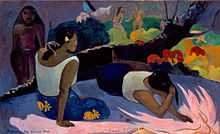
Gauguin painted Fatata te miti (By the Sea) in 1892 during his first trip to Tahiti. Like Vahine no te vi (Woman of the Mango) painted at the same time, it is an example of the relatively few straightforward genre scenes that Gauguin painted immediately after setting up his studio in a native bamboo hut at Mataiea, Papeari.[3] Nevertheless, as Nancy Mowll Mathews, biographer of Gauguin's erotic life, points out, neither represents what he actually saw; the paintings transforming the mundane and ordinary into an exoticized view of the island's life.[4] A pendant painting Arearea no varua ino (The Amusement of the Evil Spirit), executed shortly after Gauguin had returned to Paris, demonstrates how he moved on from simple genre painting, introducing symbolist elements.[3]
The painting depicts two naked Tahitian woman, seen from behind, jumping into the sea. There is a fisherman in the background, fishing with a spear. The painting epitomizes the romantic view of Tahitians made famous by Pierre Loti's Loki. The woman go bathing naked, removing their pareos, apparently unbothered by the presence of the fisherman nearby. This is an image of the uninhibited tropical paradise Gauguin had hoped to find, although the reality was that Polynesian culture had been transformed by western missionaries and colonialism as they imposed their own values and religion on the people living in the islands.[3][5]
The painting was previously owned by Chester Dale, who left his collection to the National Gallery of Art, Washington, D.C. in 1962.[6]
First Tahitian period
Looking for a society more elemental and simple than that in France, Gauguin auctioned thirty of his paintings and used the money to travel to Tahiti. This first visit lasted from 1891 to 1893. His book Noa Noa was written in the style of a travel journal and was originally meant to provide a context for his 1893 Paris exhibition. Gauguin first used the words "Noa Noa" reporting the words the Tahitians themselves used for the scent of Tahitian women: "Téiné merahi noa noa " meaning "(now) very fragrant".[7] The substantive Fenua ("land" or "island") is understood in the title of his book, so the correct translation is "The Fragrant Isle". Also implied is the Tahitian term for "Paradise" - Rohutu noanoa.[8] In the event his book remained unpublished until 1901, although extracts were publshed in La Revue Blanche in 1897.[9][10][11] The first European exhibition of Gauguin's work took place in March 1893 in Copenhagen, when he was able to take up the offer of a visiting sea captain and send out eight selected paintings.[12]
- Paintings from Gauguin's first Tahitian period selected for his Copenhagen exhibition
-
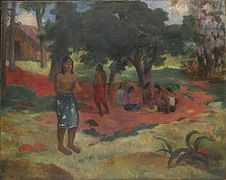
-
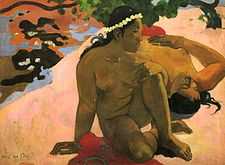
-
-
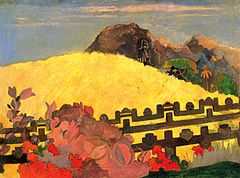
-
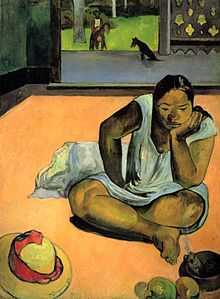
-
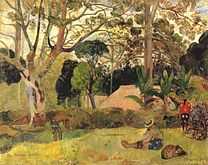
-
_-_Google_Art_Project.jpg)
-
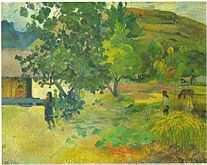
References and sources
- References
- ↑ "By the Sea (Fatata te Miti)". http://www.wga.hu/. Retrieved October 2014.
- ↑ "Paul Gauguin New York Times". http://topics.nytimes.com. Retrieved October 2014.
- ↑ 3.0 3.1 3.2 Stuckey pp. 276-7
- ↑ Mathews pp. 171-2
- ↑ "Fatata te Miti (By the Sea)". nga.gov. National Gallery of Art.
- ↑ "From Impressionism to Modernism: The Chester Dale Collection". http://arthistory.about.com. Retrieved October 2014.
- ↑ "Paul Gauguin's Noa Noa". clevelandart.org. Cleveland Museum of Art.
A mingled perfume, half animal, half vegetable emanated from them; the perfume of their blood and of the gardenias—tiaré—which they wore in their hair. "Téiné merahi noa noa (now very fragrant)," they said.
- ↑ Danielsson (1965) p. 158
- ↑ "Paul Gauguin's Noa Noa". www.clevelandart.org.
- ↑ Mathews p. 247
- ↑ "Noa Noa". bnf.fr. Bibliothèque nationale de France.
- ↑ Danielsson p. 125
- Sources
- Danielsson, Bengt (1965). Gauguin in the South Seas. Garden City, New York: Doubleday.
- Mathews, Nancy Mowll (2001). Paul Gauguin, an Erotic Life. New Haven, Connecticut: Yale University Press, ISBN 0-300-09109-5.
- Stuckey, Charles F. (1988). "The First Tahitian Years". The Art of Paul Gauguin. with Peter Zegers. National Gallery of Art. pp. 276–7. ISBN 0-8212-1723-2. LCCN 88-81005.
Further reading
- Gauguin, Paul; Morice, Charles (1901). Noa Noa: The Tahiti Journal of Paul Gauguin. In French
- Noa Noa: The Tahiti Journal of Paul Gauguin. in English
| ||||||||||||||||||||||||||||||||||
